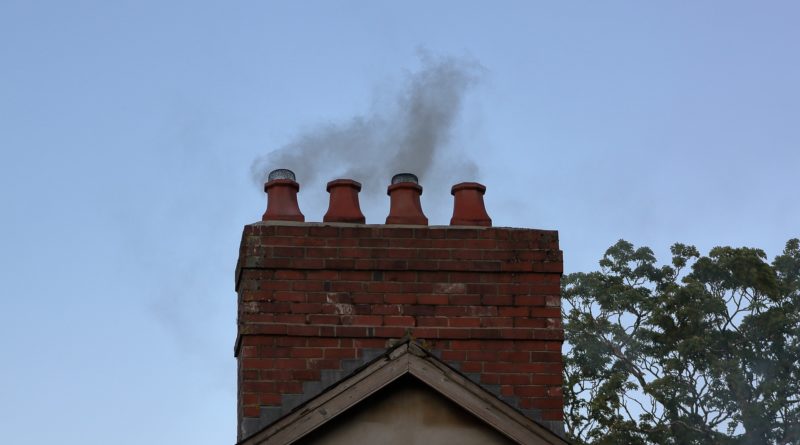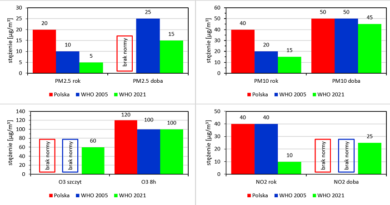Air quality assessment for 2020 – summary national report
The Chief Inspectorate for Environmental Protection has published a summary national report of the annual assessment of air quality in zones in Poland for the year 2020. The assessment was based on the results of evaluations made for individual provinces in regional departments of environmental monitoring (RDEM) of the Chief Inspectorate for Environmental Protection (CIEP).
Zones in Poland in 2020
In Poland, air quality assessment is performed by zoning, and the result is the assignment of a class to each zone for each of the assessed pollutants. The following areas are classified as zones:
• agglomeration with population over 250 thousand,
• a city (not being an agglomeration) with more than 100,000 inhabitants,
• the remaining area of the voivodeship which does not belong to agglomerations and towns with the population over 100 thousand inhabitants.
Compared with the previous year, the number of zones in Poland decreased by one (from 46 to 45), due to the fact that Legnica, with a population below 100,000, did not meet the criteria to be defined as a separate zone (we have already written about it here).
Basic information on the annual air quality assessment
Annual air quality assessment is performed in relation to substances for which normative values of air concentrations (acceptable/target/long-term objective levels) are determined by national law and EU directives. The assessment is performed taking into account criteria defined in terms of:
• human health protection,
• protection of plants.
The results of zone classification have an impact on specific requirements for actions to improve or maintain air quality. The assessment for 2020 performed on the basis of criteria established for health protection concerned 12 pollutants: sulfur dioxide (SO2), nitrogen dioxide (NO2), carbon monoxide (CO), ozone (O3), benzene (C6H6), PM10, PM2.5 and pollutants determined in PM10: benzo(a)pyrene, arsenic, cadmium, nickel and lead. The assessment in terms of criteria defined for the purpose of plant protection included 3 pollutants: sulfur dioxide (SO2), nitrogen oxides (NOX) and ozone (O3).
For all pollutants the result of the classification could be class A or C and A1 or C1 in the assessment in terms of meeting the second phase of the acceptable level defined for concentrations of PM2.5, which is in force from 1 January 2020 (the value of the second phase of the acceptable level is 5 μg/m3 lower than in the first phase and amounts to 20 μg/m3 for annual average concentration).
In the assessment concerning ozone an additional classification of zones was made – based on the long-term objective level. It results in classifying each zone as D1 or D2.
Results of the annual air quality assessment
The result of the annual air quality assessment is assigning the zone to a specific class. It should be noted that despite the possibility of significant differences in concentrations of air pollution in different areas of the zone, the whole zone is assigned one class. This class is determined on the basis of concentrations occurring in areas potentially most polluted with a given substance. As a result, even a not very large area of exceedance of the normative values determines the result of classification of the entire zone.
Assigning class A to the zone means that in the area of the zone no exceedances of the normative concentration values of the given pollutant were found in a particular year. In that case the required action is keeping concentrations of the pollutant below the acceptable or target level respectively and striving to maintain the best air quality consistent with sustainable development.
In 2020, taking into account the criteria established for health protection, out of 45 zones, the following were classified as class A:
• 45 zones for sulphur dioxide, carbon monoxide, benzene and lead, cadmium and nickel contained in PM10,
• 43 zones for particulate matter PM2.5 (acceptable level of 1st phase),
• 31 zones for particulate matter PM2.5 (phase II acceptable level),
• 29 zones for particulate matter PM10 (based on the acceptable level determined for 24-hour average concentrations),
• 44 zones for PM10 (based on the acceptable level defined for annual average concentrations),
• 6 zones for benzo(a)pyrene contained in PM10,
• 43 zones for nitrogen dioxide,
• 44 zones for arsenic,
• 42 zones for ozone.
None of the 16 zones in Poland defined for plant protection purposes exceeded the normative SO2 and NOX concentrations as well as ozone.
Assigning class C to a zone means that exceedances of acceptable or target levels plus margin of tolerance, where this margin is defined, were found on its area.
In the case of classifying a given zone to class C, the required action is to determine the areas of exceedances of the acceptable or target levels, development or updating of an air protection program, together with a short-term action plan and controlling pollution concentrations in the areas of exceedances and carrying out activities aimed at reducing concentrations at least to the acceptable or target levels.
In the assessment for 2020, taking into account the criteria established for health protection, in 39 out of 45 zones exceedances of the normative values of concentrations for one, or more than one pollutant were recorded, resulting in the assignment of class C for that pollutant to the zone (in the assessment for 2019 these were 36 out of 46 zones).
As in previous years, in 2020, most zones were classified as class C due to the occurrence of exceedances of the normative value for benzo(a)pyrene within the zone (39 out of 45 zones).
The long-term target level for ozone, which is an additional criteria for zone classification for this pollutant in terms of plant protection, was exceeded in all 16 zones assessed in the country – achieving the long-term target levels should be one of the goals of voivodeship environmental protection programs.
Classification of zones in Poland for particulate matter
As a result of the 2020 assessment based on 24-hour PM10 concentrations, 16 out of 45 zones were classified as class C. This represents a significant improvement compared to previous years: in 2019, class C was assigned to 22 (out of 46) zones, in 2018 to 39 (out of 46) zones, and in 2017 to 34 (out of 46) zones. Exceedances of the standard in 2020 were found in zones located in 9 of the 16 voivodeships.
Based on the available information on the annual average concentration of PM10, occurring in 2020, class C was assigned only to 1 zone – Małopolska, which was associated with the occurrence of exceedance in the area of the city of Nowy Targ. Also in the case of this parameter, we can mention a noticeable improvement compared to previous years. In 2019, class C was assigned to 5 zones, in 2018 – 9 (out of 46) zones, while in 2017 – 10 (out of 46) zones. Exceedances of the standard in 2020 were found in zones located in 1 of 16 voivodeships.
For PM2.5, the air quality assessment currently takes into account the acceptable level, which has been set for an annual averaging level of measurement results. As a result of the basic assessment for PM2.5 for 2020, taking into account the 2nd phase of the acceptable level, 14 out of 45 zones in the country were classified as class C1. Exceedances of the standard in 2020 were found in zones located in 8 out of 16 voivodeships.
In the case of assessment taking into account a milder criteria – the 1st phase of the level of acceptable concentration of PM2.5 in the atmospheric air, there were 2 zones in the country classified as class C. In 2019, class C was assigned to 8 zones, in 2018 – 14 (out of 46) zones, while in 2017 – 19 (out of 46) zones. Exceedances of the standard in 2020 were found in zones located in 2 out of 16 voivodeships.
Despite the noticeable decrease in the number of zones in the country assigned to class C in recent years, the problem with meeting the acceptable levels for particulate matter PM10 and PM2.5 still remains. Exceedances are related to PM10 emissions from numerous sources of the municipal and household sector (similarly to benzo(a)pyrene). This problem is particularly noticeable in winter, when solid fuel appliances are used for heating homes. A relatively large share in the formation of exceedances is also the emission from transport, especially in the centers of agglomerations and larger cities. High concentrations of PM2.5 in the air are the effect of both the primary emission of PM2.5 to the atmosphere (fuel combustion processes, road transport), and the result of the formation of secondary aerosol in the atmosphere (from dust precursors such as: SO2, NOX, NH3, volatile organic compounds, persistent organic compounds) as a result of a series of chemical reactions during which dust particles are formed from gaseous pollutants previously introduced into the atmosphere. We wrote about the ratio of PM2.5 and PM10 dust concentrations here.



